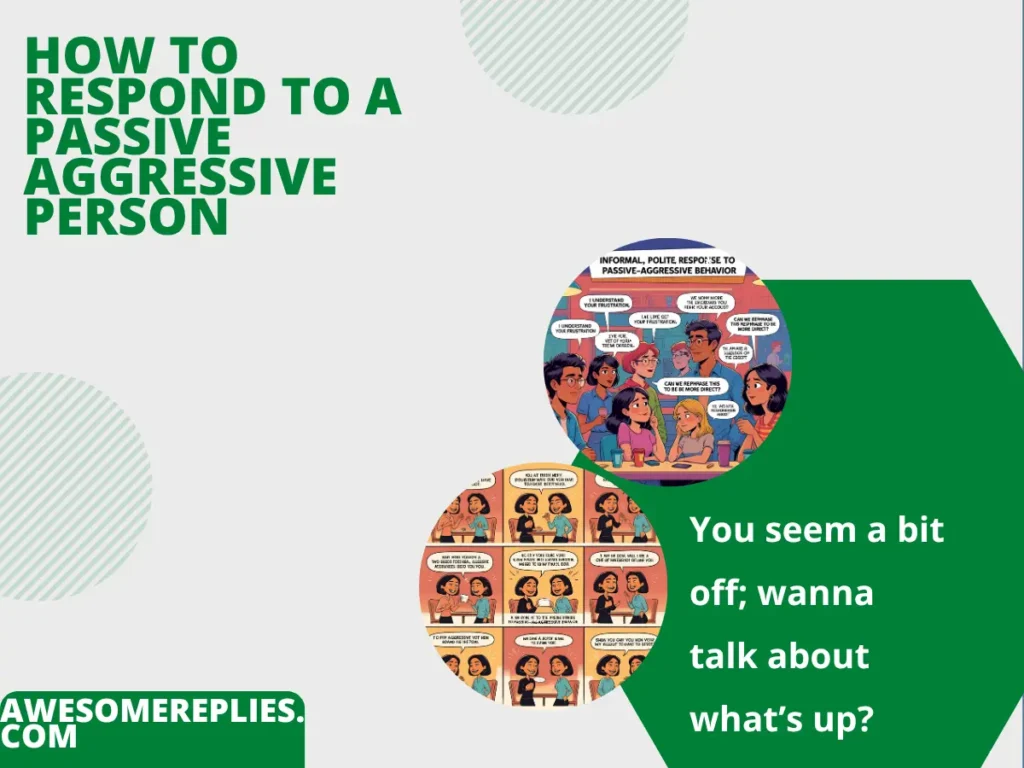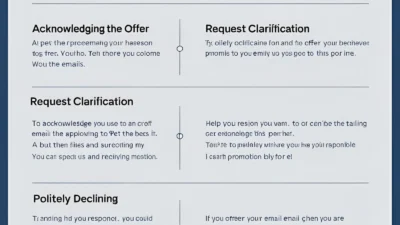Struggling to find the perfect way to handle a passive aggressive person without escalating tension? You’ve landed in the right place.
This article delivers clear, practical strategies to respond to passive aggressive behavior with confidence and tact.
Whether you’re dealing with subtle jabs at work, veiled sarcasm from a friend, or indirect hostility in a family setting, different situations call for tailored approaches to address passive aggression effectively.
From formal responses to casual comebacks, idiomatic phrases, and professional replies, we’ve got you covered with over 120 ways to navigate these tricky interactions.
Formal Ways to Respond to a Passive Aggressive Person

When faced with passive aggressive behavior in formal settings, such as professional or public environments, maintaining composure is key. These responses are polite, direct, and designed to defuse tension while addressing the behavior head-on.
- I appreciate your perspective, but could we discuss this openly to avoid misunderstandings?
- It seems there’s an underlying issue here; I’d value a direct conversation to address it.
- I sense some frustration; can we clarify your concerns to move forward constructively?
- Your comment caught my attention; could you share more details to help me understand?
- I’d prefer we address any concerns directly to keep our communication clear.
- Let’s focus on finding a solution together; what’s on your mind?
- I notice a tone in your response; is there something specific you’d like to discuss?
- I value clear communication; could you elaborate on your thoughts?
- It feels like there’s more to this; can we talk openly to resolve it?
- I’m open to feedback; could you share your thoughts directly?
- I’d like to understand your perspective better; can we discuss this calmly?
- Let’s keep this respectful and address any issues head-on.
- I sense some hesitation; is there something you’d like to clarify?
- Could we have an open discussion to ensure we’re on the same page?
- I’d appreciate it if we could address concerns directly to avoid confusion.
- Your comment seems layered; can we talk about what’s really going on?
- I’m here to listen; could you share your thoughts more clearly?
- Let’s work together to address any issues openly and respectfully.
- I notice some tension; can we discuss what’s bothering you?
- I’d value a straightforward conversation to clear up any misunderstandings.
- It feels like there’s an unspoken issue; could we talk about it?
- I’m open to hearing your concerns; let’s address them directly.
- Could we have a candid discussion to resolve any underlying issues?
- I sense some discomfort; can we talk openly to sort this out?
- I’d prefer we communicate directly to keep things productive.
- Your tone suggests something’s off; can we discuss it calmly?
- Let’s address any concerns openly to maintain a positive dialogue.
- I’m here to understand; could you share your thoughts plainly?
- I notice a hint of frustration; can we talk about what’s going on?
- I’d appreciate a direct approach to resolve any issues between us.
- Could we discuss this openly to ensure we’re both understood?
- I sense an underlying issue; let’s address it respectfully.
Informal Ways to Respond to a Passive Aggressive Person

In casual settings, like with friends or family, a lighter tone can help address passive aggressive behavior without making things awkward. These responses are friendly yet firm, keeping the conversation real.
- Hey, it feels like you’re hinting at something; wanna talk about it?
- I’m picking up a vibe; can you just say what’s up?
- Seems like you’re not saying everything; what’s really going on?
- I get a sense you’re annoyed; wanna spill the beans?
- Let’s cut to the chase; what’s bothering you?
- I feel like there’s shade here; can we just be real?
- You seem a bit off; wanna talk about what’s up?
- I’m sensing some sass; can you tell me what’s wrong?
- Let’s not beat around the bush; what’s on your mind?
- I’m getting mixed signals; can you just say it straight?
- Feels like you’re dropping hints; wanna talk it out?
- I sense a dig there; what’s really bugging you?
- Let’s keep it real; what’s the deal here?
- I’m picking up some shade; can we clear the air?
- Seems like you’re holding back; wanna share what’s up?
- I feel a vibe; can you just tell me what’s wrong?
- Let’s not play games; what’s really going on?
- I’m sensing something’s off; can we talk straight?
- Feels like you’re throwing shade; wanna be upfront?
- I get it, you’re annoyed; can we just talk about it?
- Seems like there’s more to this; what’s the real issue?
- I’m picking up a tone; can you say what’s up?
- Let’s skip the hints; what’s really bothering you?
- I feel some tension; can we just be honest?
- Seems like you’re not saying it all; wanna talk?
- I’m getting a weird vibe; can we clear things up?
- Let’s be real here; what’s the problem?
- I sense you’re upset; can you just say it?
- Feels like a hidden jab; wanna talk it out?
- I’m picking up something; can we just be open?
- Let’s not do the hint thing; what’s up?
- I feel like you’re holding back; can we talk straight?
Idiomatic Ways to Respond to a Passive Aggressive Person
Idiomatic expressions add flair and can diffuse tension with a touch of humor or cultural nuance. These phrases address passive aggression with a clever twist, perfect for various social contexts.
- Don’t beat around the bush; let’s get to the point.
- Spill the tea; what’s really going on here?
- Stop throwing shade and just say what’s up.
- Let’s not play cat and mouse; what’s the deal?
- Quit dancing around it; tell me what’s wrong.
- Don’t give me the cold shoulder; let’s talk.
- Stop dropping hints like breadcrumbs; be straight.
- Let’s cut through the fog; what’s bothering you?
- Don’t sweep it under the rug; let’s address it.
- Stop playing coy; what’s really on your mind?
- Don’t leave me in the dark; say what’s up.
- Let’s not skirt the issue; what’s the problem?
- Stop tossing curveballs; just be upfront.
- Don’t pull punches; tell me what’s wrong.
- Let’s clear the air instead of stirring the pot.
- Stop hedging your bets; say what you mean.
- Don’t keep me guessing; what’s the real issue?
- Let’s not tiptoe around it; what’s going on?
- Stop giving me the runaround; be straight with me.
- Don’t hide behind hints; let’s talk it out.
- Let’s not play hide and seek; what’s up?
- Stop circling the wagons; say what’s wrong.
- Don’t throw darts in the dark; be clear.
- Let’s not dodge the bullet; what’s the issue?
- Stop keeping it under wraps; tell me straight.
- Don’t give me the silent treatment; let’s talk.
- Let’s not pussyfoot around; what’s the deal?
- Stop dropping veiled hints; just be honest.
- Don’t keep it on the down-low; say it.
- Let’s not play mind games; what’s bothering you?
- Stop skirting around it; let’s get real.
- Don’t throw side-eye; just tell me what’s up.
Professional Ways to Respond to a Passive Aggressive Person
In workplace settings, responding to passive aggressive behavior requires professionalism and clarity to maintain a productive environment. These phrases are tailored for emails, meetings, or formal interactions.
- I’d appreciate a direct discussion to address any concerns you have.
- Let’s ensure our communication remains clear and constructive.
- I sense some underlying tension; can we discuss it openly?
- Could we address any issues directly to maintain a positive workflow?
- I value your input; let’s discuss this candidly to move forward.
- It seems there’s more to this; can we talk it through professionally?
- I’d like to clarify your perspective; could we discuss this directly?
- Let’s keep our dialogue open and focused on solutions.
- I notice some hesitation; can we address any concerns head-on?
- I’m open to feedback; could you share your thoughts clearly?
- Let’s work together to resolve any issues in a straightforward manner.
- I sense some frustration; can we discuss it to find a solution?
- I’d prefer we address concerns directly to ensure clarity.
- Could we have an open conversation to align our perspectives?
- I notice a tone in your response; can we clarify the issue?
- Let’s maintain a professional dialogue to address any concerns.
- I’m here to understand; could you share your thoughts directly?
- I sense an underlying issue; let’s discuss it constructively.
- I’d appreciate a candid conversation to resolve any misunderstandings.
- Let’s focus on clear communication to keep our work productive.
- I notice some tension; can we address it openly?
- I’m open to hearing your concerns; let’s discuss them directly.
- Could we talk openly to ensure we’re on the same page?
- I sense some discomfort; let’s address it professionally.
- I’d value a direct approach to resolve any workplace issues.
- Let’s keep our communication transparent and solution-focused.
- I notice a hint of frustration; can we discuss it calmly?
- I’m here to listen; could you share your concerns plainly?
- Let’s address any issues directly to maintain a positive environment.
- I’d appreciate an open dialogue to clear up any concerns.
- Could we discuss this candidly to ensure a smooth collaboration?
- I sense something’s off; let’s talk it through professionally.
Conclusion
Navigating passive aggressive behavior can be challenging, but choosing the right response makes all the difference.
Whether you’re in a formal setting, a casual conversation, or a professional environment, using the appropriate phrase helps you address the behavior without escalating conflict.
These 120+ responses give you the tools to handle subtle jabs, veiled sarcasm, or indirect hostility with confidence and clarity.
Practice these phrases in your daily interactions to build stronger, more open communication.
Start using them today to take control of tricky conversations and foster healthier relationships.



